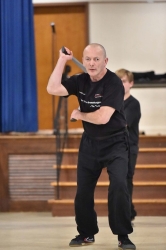
The training methods of Dekiti Tirsia Siradas Kali are derived directly from its name. The language is of the Ilongo dialect of the Visayan region of the Philippines. The word Dekiti means close range, or tightly close, which is the combat range preferred by the DTS combatant. Tirsia is close quarter quartering, which is the ideal punishment you should hand out to your opponent. Siradas means too close off, corner making escape impossible, driving them back to their finish.
Now realizing that the first key to Dekiti is footwork we need to have a solid foundation with both the offensive and defensive sets. We should train the offensive footwork to take advantage of our opponent’s movement to be able to close the range to close and apply the principles of Tersia and finally Siradas. On the defensive side of the footwork, we would use the double step to capture and attack the attack, using foot movement similar to Aikido or Capoeira.
Training the offensive footwork should be done forward 12 steps, minimum, and 12 steps reverse minimum. From here you can add any of the weapons used in Dekiti Tirsia Siradas or empty hand works just as well. SGM Nene likes to use this drilling method to increase cardio as well, I like it for a quick warm-up for the day’s workout. When training the defensive footwork I like to use a timer, usually setting it for 30 seconds to 1 minute. We should work our 45* angles 90* angles and 180* angles.
Now that we are well versed in our footwork we would add the weaponry to our training sessions, Typically we start with the Baston the 28” rattan stick, working the 12 strikes into our footwork as well as stationary practice. To increase the intensity of your basic Baston training you can set a timer for 30 seconds per strike 1-12 then add a stick to your left hand and work the 12 strikes with each.
Seeing that within the system of Dekiti Tirsia Siradas, all the weaponry is interchangeable with only minor changes to the location of a few strikes it would be advisable now to swap out the different weapons in trying to see how they feel. I would suggest starting with the long weapons, Talibong, Gununting, and hand axe(Wasia). You’ll right away feel the difference in weight and balance. My favorite for the weight training aspect would be the hand axe. If you prefer something without a blade you could use a rubber mallet. It will give you the approximate weight and feel. Using double weapons, Baston, Talibong, or Hand Axe is also a great gateway to Espada Data.
We must never underestimate the use of body mechanics, the second Key to Dekiti Tirsia Siradas Kali. As we move the body and position it for combat we should always remember the angles in the joints, especially the knees and elbows. SGM Nene will always insist upon a 45* arch in front of the combative limb of course the converse angle is 135*. If you ever see a good Thai pad holder, you’ll notice that their hand are held at 135* Using this technology, this science from Dekiti Tersia, My instructor Nene Tortal can and will stop and control a much larger opponent. I love to test and use the structure of Dekiti Tersia against various sizes opponents.
On the other side, I have had students who have not had the forethought in training to use these principles and end up getting knocked on their butt. Body mechanics is also used in the proper execution of hand strikes and kicks. Powerful attacks should come from the ground using the body as a conduit, like a giant spring, or hydraulic system. Proper body mechanics are essential In delivering the most powerful kicks you can, Knowing the difference between your elbows and your button is a good thing.
The last is hand manipulation. When discussing the disposition of any weapon we first want to talk about where the hands are and what they are doing. When you start training in most traditional forms of martial arts you start with your hands in chamber, fists tucked alongside the body. Now there are many reasons for the hands to be there, with beginners knowing where your tools are, ie hand is of primary importance. Many times I see students with their hands hanging by their butts, and I always tell them they are protecting the wrong set of cheeks. Always be aware of the disposition of your weapon ”hands” so you may counter your opponent easily. Now that we know where our hands are we can employ them to counter, trap and apply locks to our opponent. The most common locks used in Dekiti Tiorsia Sirradas are the outward wrist flex and the nekio or z lock. These can be applied after a disarm or to assist in the disarm. Takedowns with the locks or follow-up with other locks and holds may be applied at various stages during the technique.
The outcome of our practice is derived from the forethought of training. As we work on one aspect we must realize and feel the aspects of the other. Anyone can be a great martial artist all it takes is mastering the basics. The training methodologies in Dekiti Tirsia Siradas Kali promote the functional attributes of the practitioner, the more you practice the basics the quicker you get there. We must also remember what SGM Nene always says, “always practice properly”.
- The Martial Effectiveness of Drills in Filipino Martial Arts (FMA) - February 5, 2025
- The Resurgence of Traditional Martial Arts in Modern Mixed Martial Arts - January 7, 2025
- The Night Christmas Almost Died - December 21, 2024

Leave a Reply